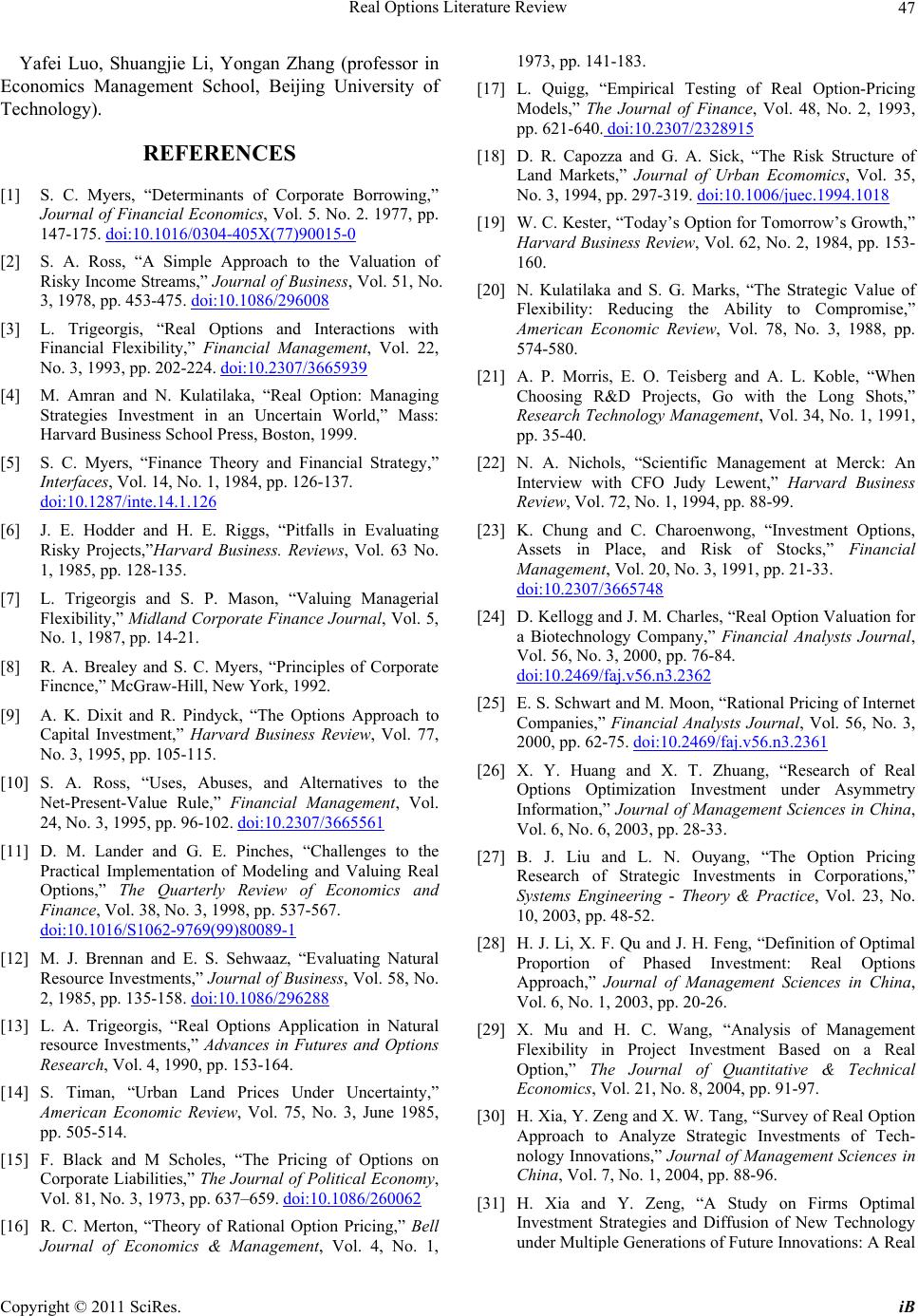
Real Options Literature Review47
Yafei Luo, Shuangjie Li, Yongan Zhang (professor in
Economics Management School, Beijing University of
Technology).
REFERENCES
[1] S. C. Myers, “Determinants of Corporate Borrowing,”
Journal of Financial Economics, Vol. 5. No. 2. 1977, pp.
147-175. doi:10.1016/0304-405X(77)90015-0
[2] S. A. Ross, “A Simple Approach to the Valuation of
Risky Income Streams,” Journal of Business, Vol. 51, No.
3, 1978, pp. 453-475. doi:10.1086/296008
[3] L. Trigeorgis, “Real Options and Interactions with
Financial Flexibility,” Financial Management, Vol. 22,
No. 3, 1993, pp. 202-224. doi:10.2307/3665939
[4] M. Amran and N. Kulatilaka, “Real Option: Managing
Strategies Investment in an Uncertain World,” Mass:
Harvard Business School Press, Boston, 1999.
[5] S. C. Myers, “Finance Theory and Financial Strategy,”
Interfaces, Vol. 14, No. 1, 1984, pp. 126-137.
doi:10.1287/inte.14.1.126
[6] J. E. Hodder and H. E. Riggs, “Pitfalls in Evaluating
Risky Projects,”Harvard Business. Reviews, Vol. 63 No.
1, 1985, pp. 128-135.
[7] L. Trigeorgis and S. P. Mason, “Valuing Managerial
Flexibility,” Midland Corporate Finance Journal, Vol. 5,
No. 1, 1987, pp. 14-21.
[8] R. A. Brealey and S. C. Myers, “Principles of Corporate
Fincnce,” McGraw-Hill, New York, 1992.
[9] A. K. Dixit and R. Pindyck, “The Options Approach to
Capital Investment,” Harvard Business Review, Vol. 77,
No. 3, 1995, pp. 105-115.
[10] S. A. Ross, “Uses, Abuses, and Alternatives to the
Net-Present-Value Rule,” Financial Management, Vol.
24, No. 3, 1995, pp. 96-102. doi:10.2307/3665561
[11] D. M. Lander and G. E. Pinches, “Challenges to the
Practical Implementation of Modeling and Valuing Real
Options,” The Quarterly Review of Economics and
Finance, Vol. 38, No. 3, 1998, pp. 537-567.
doi:10.1016/S1062-9769(99)80089-1
[12] M. J. Brennan and E. S. Sehwaaz, “Evaluating Natural
Resource Investments,” Journal of Business, Vol. 58, No.
2, 1985, pp. 135-158. doi:10.1086/296288
[13] L. A. Trigeorgis, “Real Options Application in Natural
resource Investments,” Advances in Futures and Options
Research, Vol. 4, 1990, pp. 153-164.
[14] S. Timan, “Urban Land Prices Under Uncertainty,”
American Economic Review, Vol. 75, No. 3, June 1985,
pp. 505-514.
[15] F. Black and M Scholes, “The Pricing of Options on
Corporate Liabilities,” The Journal of Political Economy,
Vol. 81, No. 3, 1973, pp. 637–659. doi:10.1086/260062
[16] R. C. Merton, “Theory of Rational Option Pricing,” Bell
Journal of Economics & Management, Vol. 4, No. 1,
1973, pp. 141-183.
[17] L. Quigg, “Empirical Testing of Real Option-Pricing
Models,” The Journal of Finance, Vol. 48, No. 2, 1993,
pp. 621-640. doi:10.2307/2328915
[18] D. R. Capozza and G. A. Sick, “The Risk Structure of
Land Markets,” Journal of Urban Ecomomics, Vol. 35,
No. 3, 1994, pp. 297-319. doi:10.1006/juec.1994.1018
[19] W. C. Kester, “Today’s Option for Tomorrow’s Growth,”
Harvard Business Review, Vol. 62, No. 2, 1984, pp. 153-
160.
[20] N. Kulatilaka and S. G. Marks, “The Strategic Value of
Flexibility: Reducing the Ability to Compromise,”
American Economic Review, Vol. 78, No. 3, 1988, pp.
574-580.
[21] A. P. Morris, E. O. Teisberg and A. L. Koble, “When
Choosing R&D Projects, Go with the Long Shots,”
Research Technology Management, Vol. 34, No. 1, 1991,
pp. 35-40.
[22] N. A. Nichols, “Scientific Management at Merck: An
Interview with CFO Judy Lewent,” Harvard Business
Review, Vol. 72, No. 1, 1994, pp. 88-99.
[23] K. Chung and C. Charoenwong, “Investment Options,
Assets in Place, and Risk of Stocks,” Financial
Management, Vol. 20, No. 3, 1991, pp. 21-33.
doi:10.2307/3665748
[24] D. Kellogg and J. M. Charles, “Real Option Valuation for
a Biotechnology Company,” Financial Analysts Journal,
Vol. 56, No. 3, 2000, pp. 76-84.
doi:10.2469/faj.v56.n3.2362
[25] E. S. Schwart and M. Moon, “Rational Pricing of Internet
Companies,” Financial Analysts Journal, Vol. 56, No. 3,
2000, pp. 62-75. doi:10.2469/faj.v56.n3.2361
[26] X. Y. Huang and X. T. Zhuang, “Research of Real
Options Optimization Investment under Asymmetry
Information,” Journal of Management Sciences in China,
Vol. 6, No. 6, 2003, pp. 28-33.
[27] B. J. Liu and L. N. Ouyang, “The Option Pricing
Research of Strategic Investments in Corporations,”
Systems Engineering - Theory & Practice, Vol. 23, No.
10, 2003, pp. 48-52.
[28] H. J. Li, X. F. Qu and J. H. Feng, “Definition of Optimal
Proportion of Phased Investment: Real Options
Approach,” Journal of Management Sciences in China,
Vol. 6, No. 1, 2003, pp. 20-26.
[29] X. Mu and H. C. Wang, “Analysis of Management
Flexibility in Project Investment Based on a Real
Option,” The Journal of Quantitative & Technical
Economics, Vol. 21, No. 8, 2004, pp. 91-97.
[30] H. Xia, Y. Zeng and X. W. Tang, “Survey of Real Option
Approach to Analyze Strategic Investments of Tech-
nology Innovations,” Journal of Management Sciences in
China, Vol. 7, No. 1, 2004, pp. 88-96.
[31] H. Xia and Y. Zeng, “A Study on Firms Optimal
Investment Strategies and Diffusion of New Technology
under Multiple Generations of Future Innovations: A Real
Copyright © 2011 SciRes. iB